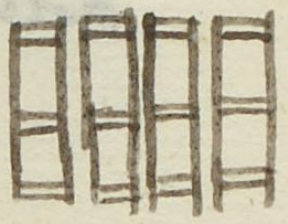Nauhacatl (MH653r)
This black-line drawing of the compound glyph for the personal name Nahuacatl or Nauhacatl (which can also be spelled "Nahui Acatl," "Four Reed" or "4-Reed") is attested here as a man's name. This is a name that derives from the religious divinatory calendar called the tonalpohualli. Acatl is a day name, and the companion number here is four (nahui). Parents would often name a baby based upon the date of the birth in this calendar, and the child's fate was believed to be affected by what the calendar portended. The four reeds are vertical here, and they are segmented much like bamboo.
Stephanie Wood
The name Nahuacatl or Nauhacatl had been held by a famous Nahua, the sixth son of Tizocic, according to Tezozomoc (1598), as cited in the Gran Diccionario Náhuatl, https://gdn.iib.unam.mx/diccionario/nahuacatl.
Stephanie Wood
juā navacatl
Juan Nauhacatl
Stephanie Wood
1560
Jeff Haskett-Wood
nahuacatl, números, cuatro, cañas, nombres famosos, nombres de hombres, calendarios, días, años, nahuacatl, tonalpohualli

nahui, four, https://nahuatl.wired-humanities.org/content/nahui
aca(tl), reed or cane, https://nahuatl.wired-humanities.org/content/acatl
Cuatro Caña, o 4-Caña
Stephanie Wood
Matrícula de Huexotzinco, folio 653r, World Digital Library, https://www.loc.gov/resource/gdcwdl.wdl_15282/?sp=388&st=image
This manuscript is hosted by the Library of Congress and the World Digital Library; used here with the Creative Commons, “Attribution-NonCommercial-ShareAlike 3.0 License” (CC-BY-NC-SAq 3.0).





